Abstract
Flavonoids have been shown to affect calcium signaling in neurons. However, there are no reports on the effect of apigenin on glutamate-induced calcium signaling in neurons. We investigated whether apigenin affects glutamate-induced increase of free intracellular Ca2+ concentration ([Ca2+]i) in cultured rat hippocampal neurons, using fura-2-based digital calcium imaging and microfluorimetry. The hippocampal neurons were used between 10 and 13 days in culture from embryonic day 18 rats. Pretreatment of the cells with apigenin (1μM to 100μM) for 5 min inhibited glutamate (100μM, 1 min) induced [Ca2+]i increase, concentration-dependently. Pretreatment with apigenin (30μM) for 5 min significantly decreased the [Ca2+]i responses induced by two ionotropic glutamate receptor agonists, alpha-amino-3-hydroxy-5-methyl-4-isoxazolepropionic (AMPA, 10μM, 1 min) and N-methyl-D-aspartate (NMDA, 100μM, 1 min), and significantly inhibited the AMPA-induced peak currents. Treatment with apigenin also significantly inhibited the [Ca2+]i response induced by 50 mM KCl solution, decreased the [Ca2+]i responses induced by the metabotropic glutamate receptor agonist, (S)-3,5-dihydroxy-phenylglycine (DHPG, 100μM, 90 s), and inhibited the caffeine (10 mM, 2 min)-induced [Ca2+]i responses. Furthermore, treatment with apigenin (30μM) significantly inhibited the amplitude and frequency of 0.1 mM [Mg2+]o-induced [Ca2+]i spikes. These data together suggest that apigenin inhibits glutamate-induced calcium signaling in cultured rat hippocampal neurons.
Go to : 
REFERENCES
Abel A., Wittau N., Wieland T., Schultz G., Kalkbrenner F. Cell cycle-dependent coupling of the vasopressin V1a receptor to different G proteins. J Biol Chem. 275:32543–32551. 2000.

Bennett DL., Bootman MD., Berridge MJ., Cheek TR. Ca2+ entry into PC12 cells initiated by ryanodine receptors or inositol 1,4,5-trisphosphate receptors. Biochem J. 329(Pt 2):349–57. 1998.

Conn PJ., Pin JP. Pharmacology and functions of metabotropic glutamate receptors. Annu Rev Pharmacol Toxicol. 37:205–237. 1997.

Fagni L., Chavis P., Ango F., Bockaert J. Complex interactions between mGluRs, intracellular Ca2+ stores and ion channels in neurons. Trends Neurosci. 23:80–88. 2000.

Ko FN., Huang TF., Teng CM. Vasodilatory action mechanisms of apigenin isolated from Apium graveolens in rat thoracic aorta. Biochim Biophys Acta. 1115:69–74. 1991.

Llano I., DiPolo R., Marty A. Calcium-induced calcium release in cerebellar Purkinje cells. Neuron. 12:663–673. 1994.

Losi G., Puia G., Garzon G., de Vuono MC., Baraldi M. Apigenin modulates GABAergic and glutamatergic transmission in cultured cortical neurons. Eur J Pharmacol. 502:41–46. 2004.

Lujan R., Nusser Z., Roberts JD., Shigemoto R., Somogyi P. Perisynaptic location of metabotropic glutamate receptors mGluR1 and mGluR5 on dendrites and dendritic spines in the rat hippocampus. Eur J Neurosci. 8:1488–1500. 1996.
Markakis EA., Palmer TD., Randolph-Moore L., Rakic P., Gage FH. Novel neuronal phenotypes from neural progenitor cells. J Neurosci. 24:2886–2897. 2004.

Martin LJ., Blackstone CD., Huganir RL., Price DL. Cellular localization of a metabotropic glutamate receptor in rat brain. Neuron. 9:259–270. 1992.

Ogoshi F., Weiss JH. Heterogeneity of Ca2+-permeable AMPA/kainate channel expression in hippocampal pyramidal neurons: fluorescence imaging and immunocytochemical assessment. J Neurosci. 23:10521–10530. 2003.

Rhie D-J., Sung J-H., Kim HJ., Ha U-S., Min DS., Kim M-S., Jo Y-H., Hahn SJ., Yoon SH. Endogenous somatostatin receptors mobilize calcium from inositol 1,4,5-trisphosphate-sensitive stores in NG108-15 cells. Brain Res. 975:120–128. 2003.

Rose K., Christine CW., Choi DW. Magnesium removal induces paroxysmal neuronal firing and NMDA receptor-mediated neuronal degeneration in cortical cultures. Neurosci Lett. 115:313–317. 1990.

Sandler VM., Barbara JG. Calcium-induced calcium release contributes to action potential-evoked calcium transients in hippocampal CA1 pyramidal neurons. J Neurosci. 19:4325–4336. 1999.

Sattler R., Tymianski M. Molecular mechanisms of calcium-dependent excitotoxicity. J Mol Med. 78:3–13. 2000.

Shen M., Piser TM., Seybold VS., Thayer SA. Cannabinoid receptor agonists inhibit glutamatergic synaptic transmission in rat hippocampal cultures. J Neurosci. 16:4322–4334. 1996.

Shigemoto R., Nomura S., Ohishi H., Sugihara H., Nakanishi S., Mizuno N. Immunohistochemical localization of a metabotropic glutamate receptor, mGluR5, in the rat brain. Neurosci Lett. 163:53–57. 1993.

Shim EY., Kim HJ., Kim MJ., Rhie DJ., Jo YH., Kim MS., Hahn JS., Lee MY., Yoon SH. Desensitization of somatostatin-induced inhibition of low extracellular magnesium concentration-induced calcium spikes in cultured rat hippocampal neurons. Brain Res. 1111:61–71. 2006.
Thayer SA., Sturek M., Miller RJ. Measurement of neuronal Ca2+ transients using simultaneous microfluorimetry and electrophysiology. Pflugers Archiv – Eur J Physiol. 412:216–223. 1988.

Wang CN., Chi CW., Lin YL., Chen CF., Shiao YJ. The neuroprotective effects of phytoestrogens on amyloid beta protein-induced toxicity are mediated by abrogating the activation of caspase cascade in rat cortical neurons. J Biol Chem. 276:5287–5295. 2001.
Go to : 
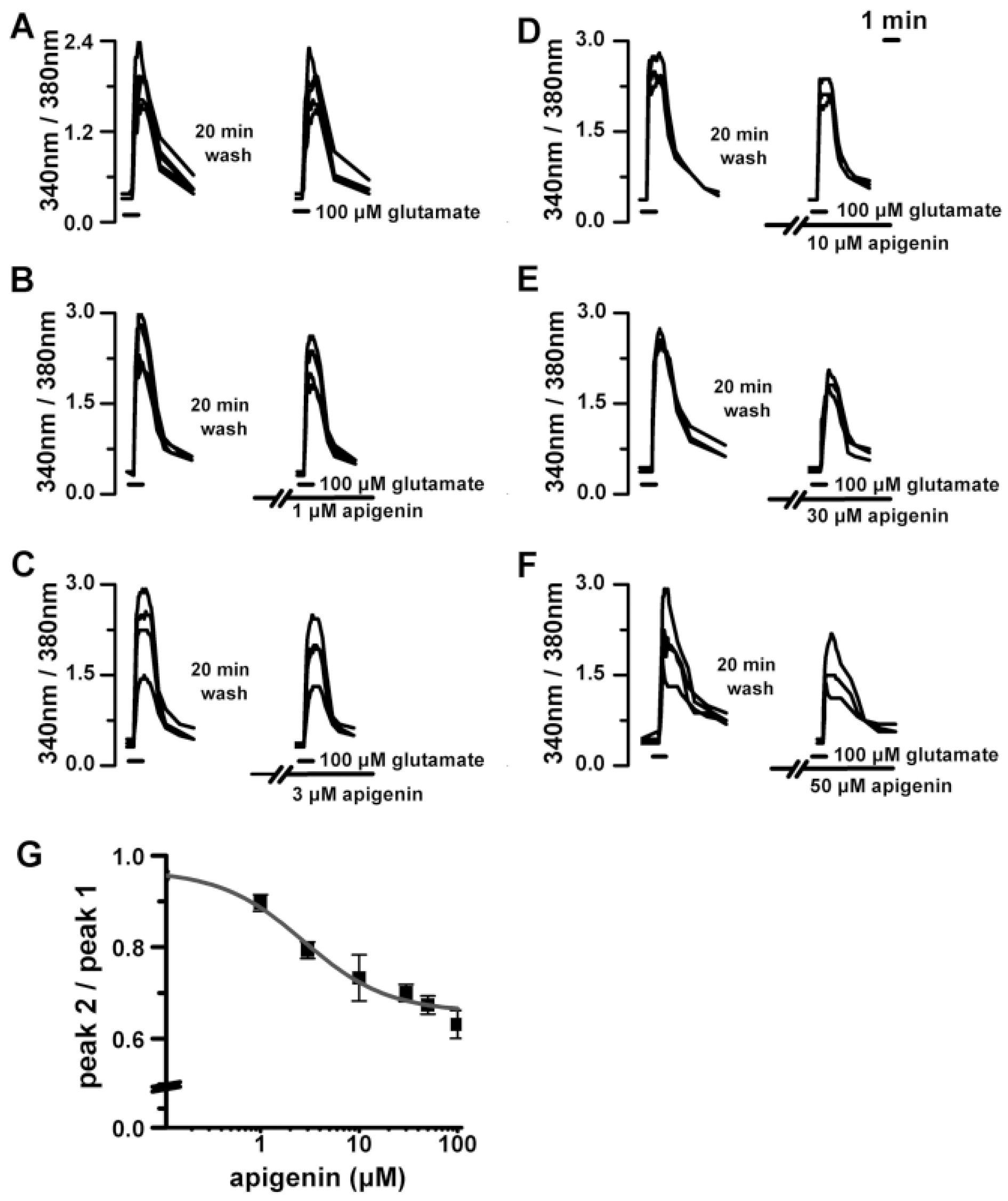 | Fig. 1.Apigenin inhibits glutamate-induced [Ca2+]i increases in cultured rat hippocampal neurons. A, Reproducible glutamate-induced [Ca2+]i increases were induced by treatment with glutamate (100μM) for 1 min at 20 min intervals. B-F, Pretreatment with apigenin for 5 min inhibited the glutamate-induced responses in a concentration dependent manner. G, Plot summarizes the inhibition of the glutamate-induced [Ca2+]i increases by apigenin (1μM, n=8; 3μM, n=15; 10μM, n=17; 30μM, n=14; 50μM, n=13; 100μM, n=17). Glutamate-induced response is presented as a percentage of initial glutamate-induced [Ca2+]i response (peak 2/peak 1) for apigenin pretreated cells. Data are expressed as means±SEM. |
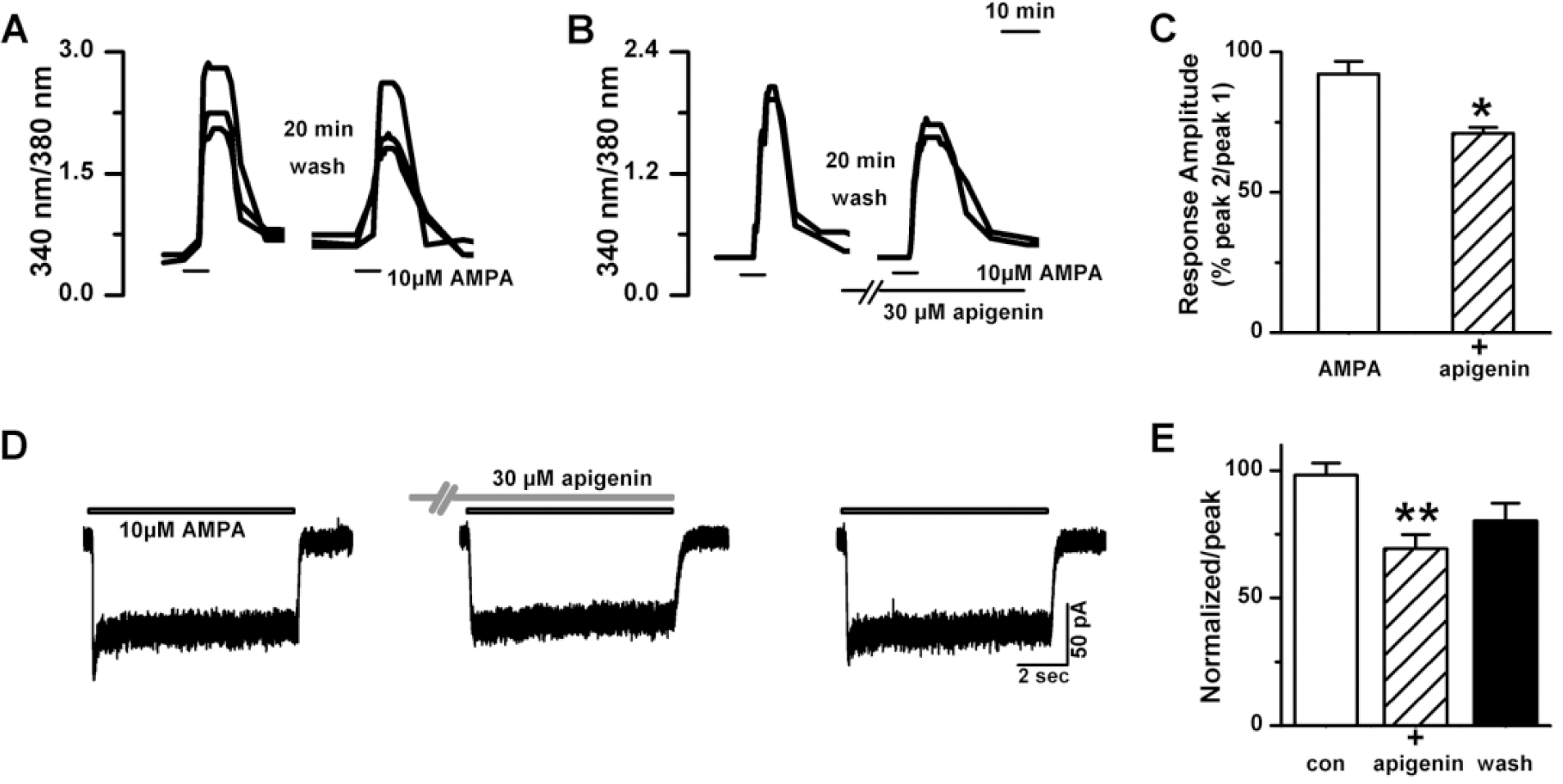 | Fig. 2.Apigenin inhibits AMPA-induced [Ca2+]i increases and currents. A, Reproducible AMPA-induced [Ca2+]i increases were induced by treatment with 10μM (s)-AMPA for 1 min. B, Pretreatment with apigenin (30μM) for 5 min decreased the AMPA-induced [Ca2+]i increases. C, Graph summarizes the effect of apigenin on the AMPA-induced [Ca2+]i increases (AMPA, n=16; + apigenin, n=16). D, Inhibitory effects of apigenin on AMPA-induced inward currents. Application of AMPA (10μM, 10 s) evoked inward currents. Pretreatment with apigenin (30μM) for 5 min inhibited the AMPA-induced inward currents. E, Graph summarizes the effect of apigenin on AMPA-induced peak current (Ipeak) (AMPA, n=6; + apigenin, n=6). Data are expressed as means±SEM. ∗p<0.05 relative to AMPA (unpaired Student's t-test) ∗∗p<0.05 relative to AMPA (paired Student's t-test). |
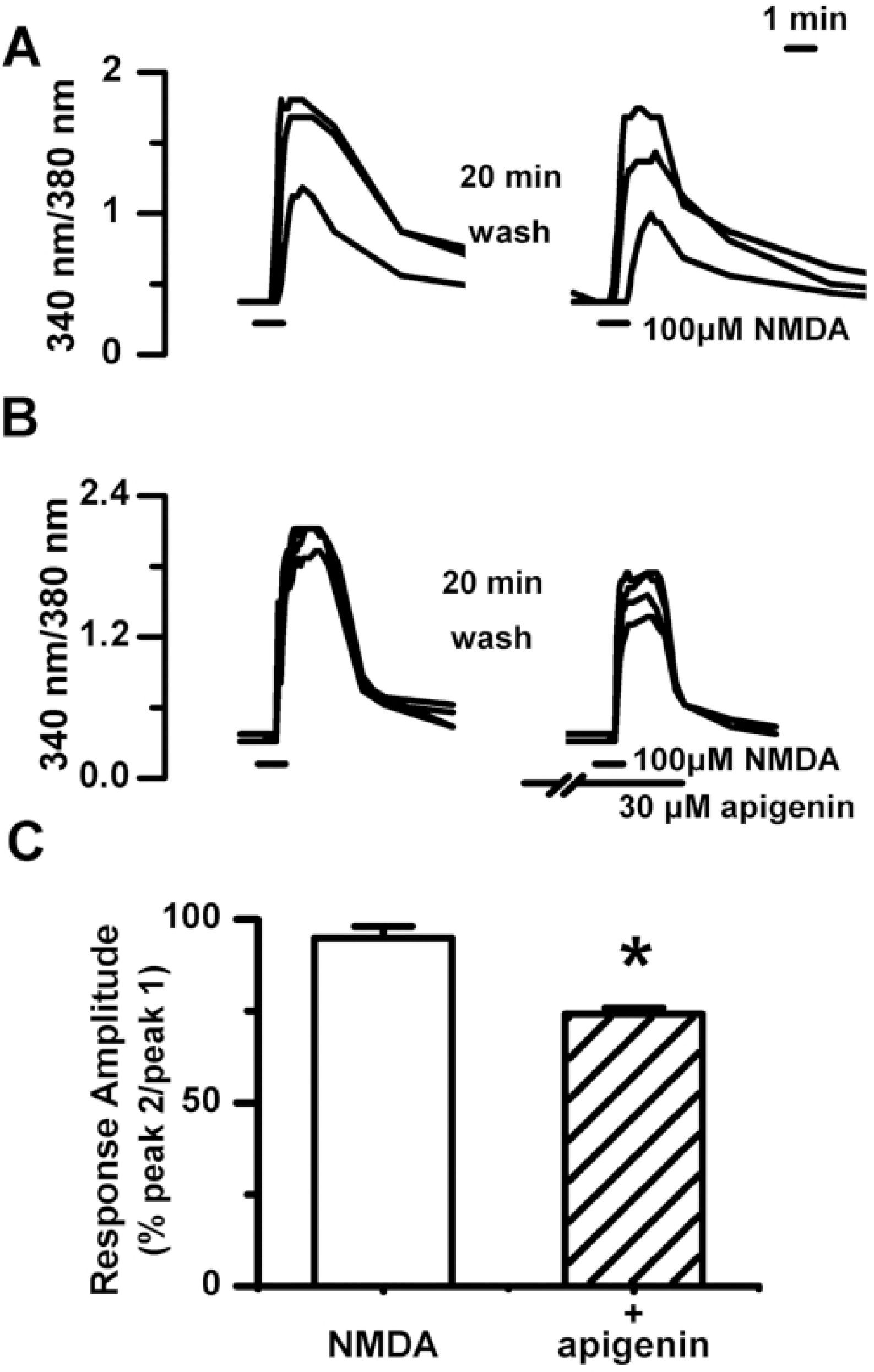 | Fig. 3.Apigenin inhibits NMDA-induced [Ca2+]i increases. A, Reproducible NMDA- induced [Ca2+]i increases were induced by treatment with 100μM NMDA for 1 min. B, Pretreatment with apigenin (30μM) for 5 min decreased the NMDA-induced responses. C, Graph summarizes the effect of apigenin on the NMDA-induced responses (NMDA, n=17; + apigenin, n=13). Data are expressed as means±SEM. ∗p<0.05 relative to NMDA (unpaired Student's t-test). |
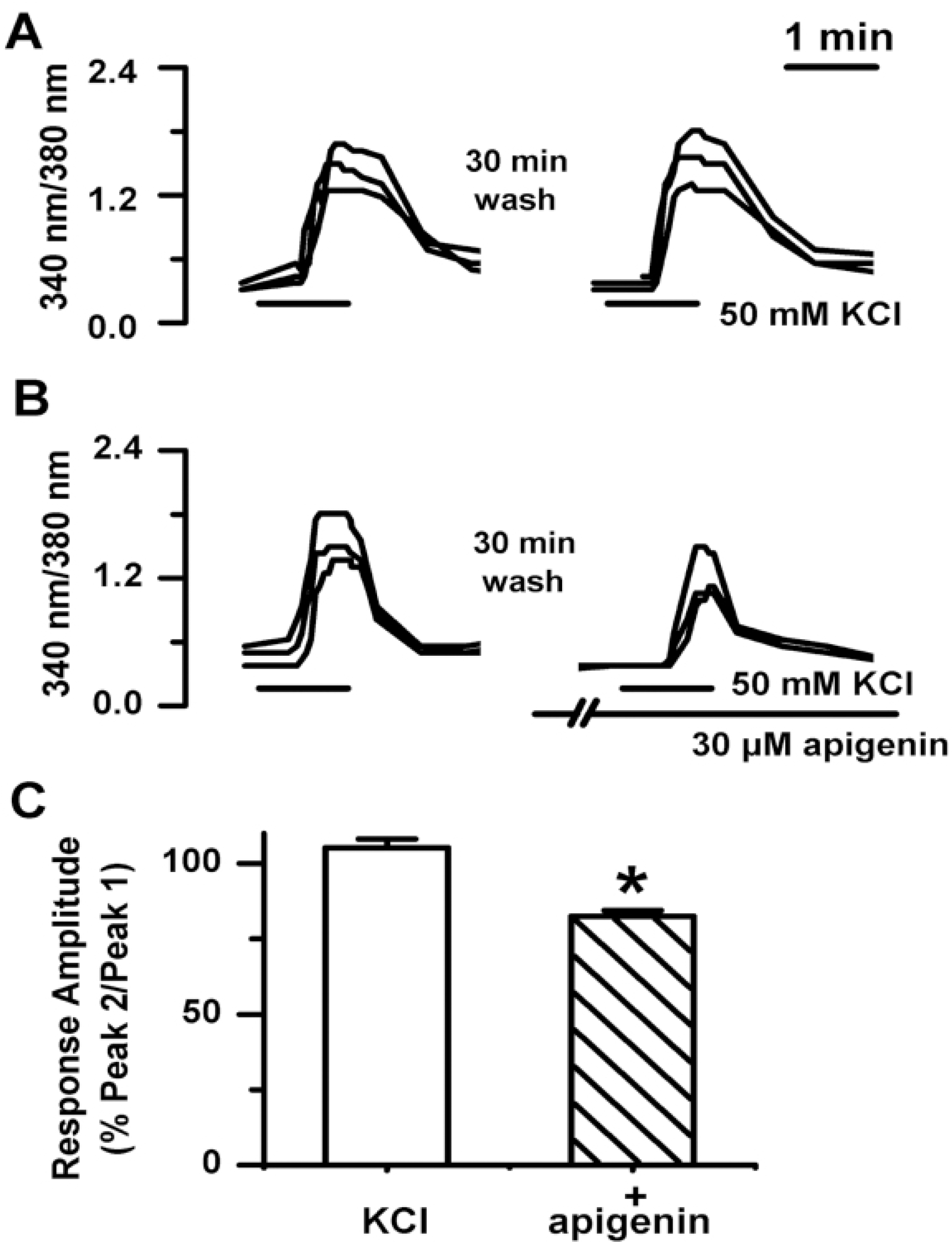 | Fig. 4.Apigenin inhibits the high K+-induced [Ca2+]i increases. A, Reproducible high K+-induced [Ca2+]i increases were induced by treatment with HHSS containing 50 mM KCl for 1 min at 30 min intervals. B, Pretreatment with apigenin (30μM) for 5 min decreased the high K+-induced responses. C, Graph summarizes the effect of apigenin on the high K+-induced responses (KCl, n = 63; + apigenin, n=17). Data are expressed as means±SEM. ∗p<0.05 relative to KCl (unpaired Student's t-test). |
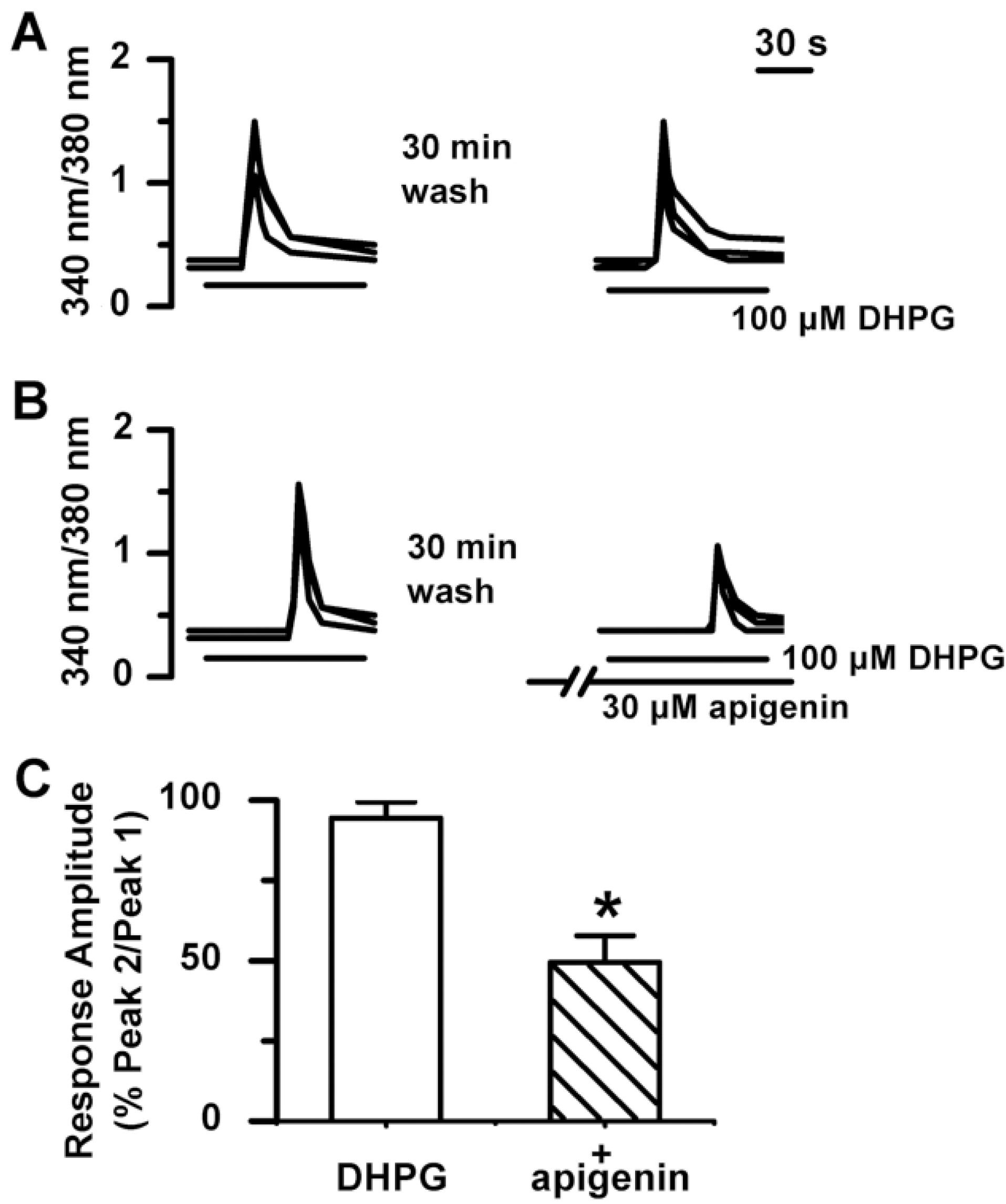 | Fig. 5.Apigenin inhibits [Ca2+]i increases induced by group I mGluR agonist DHPG. A, Reproducible DHPG-induced [Ca2+]i increases were induced by treatment with 100μM DHPG for 90 s at 30 min intervals. B, Pretreatment with apigenin (30μM) for 5 min decreased the DHPG-induced responses. C, Graph summarizes the effect of apigenin on the DHPG-induced responses (DHPG, n=35; + apigenin, n=25). Data are expressed as means±SEM. ∗p<0.05 relative to DHPG (unpaired Student's t-test). |
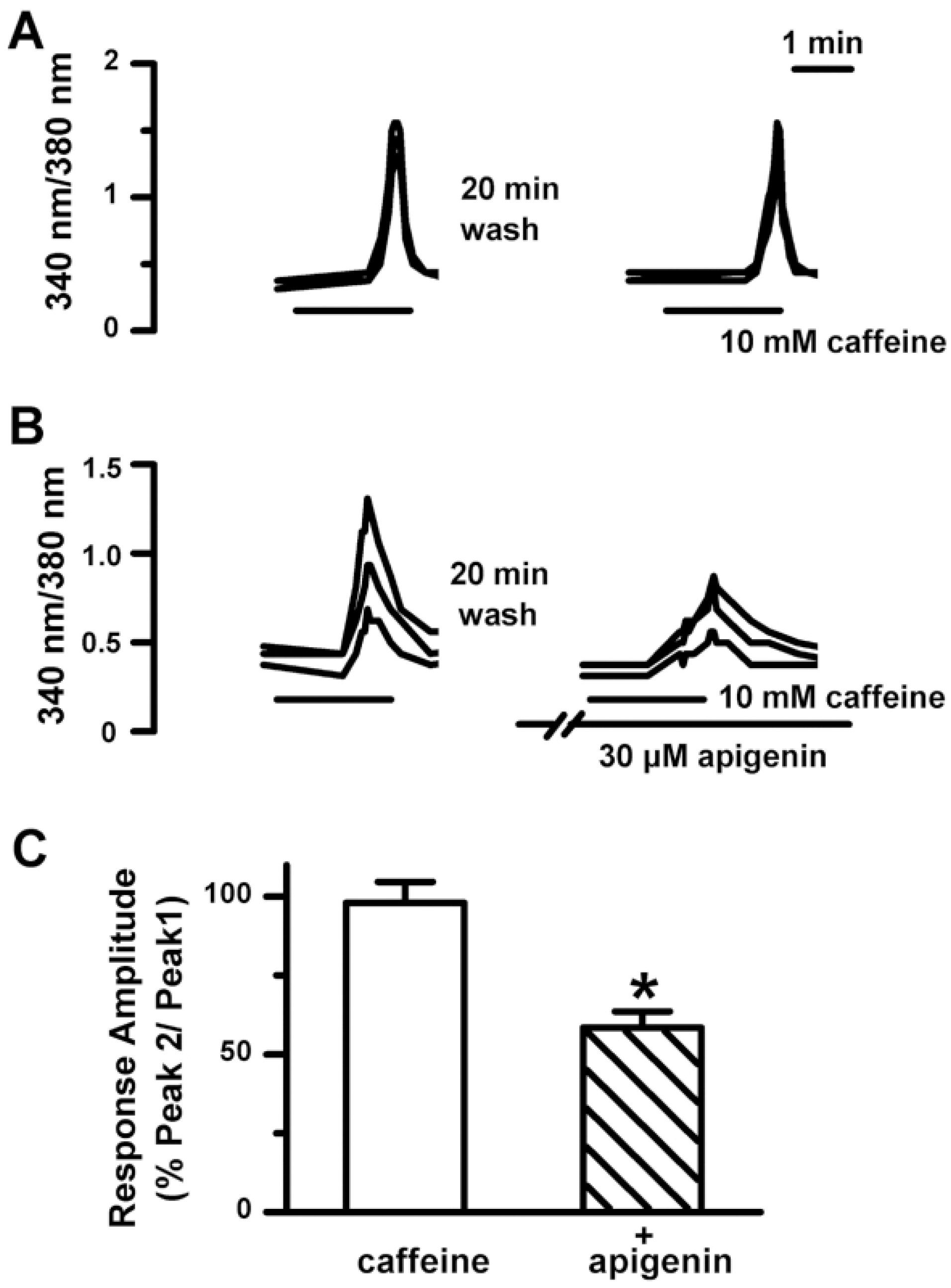 | Fig. 6.Apigenin inhibits the caffeine-induced [Ca2+]i increases. A, Reproducible caffeine-induced [Ca2+]i increases were induced by treatment with 10 mM caffeine for 2 min at 20 min intervals. B, Pretreatment with apigenin (30μM) for 5 min decreased the caffeine-induced responses. C, Graph summarizes the effect of apigenin on the caffeine-induced responses (10 mM caffeine, n=11; + apigenin, n=20). Data are expressed as means±SEM. ∗p<0.05 relative to caffeine (unpaired Student's t-test). |
 | Fig. 7.Apigenin inhibits synaptically mediated Ca2+ spikes induced by treatment with 0.1 mM [Mg2+]o in a cultured rat hippocampal neuron. A, Reducing the extracellular Mg2+ concentration ([Mg2+]o) to 0.1 mM induced [Ca2+]i spikes. B, Treatment with apigenin (30 μM) inhibits the [Ca2+]i spikes. C1 & C2, Graph summarizes the effect of apigenin on 0.1mM [Mg2+]o-induced [Ca2+]i spikes (control, n=4; + apigenin, n=4) Data are expressed as means±SEM. ∗p<0.05 relative to 0.1mM [Ma2+]o (unpaired Student's t-test). |




 PDF
PDF ePub
ePub Citation
Citation Print
Print


 XML Download
XML Download